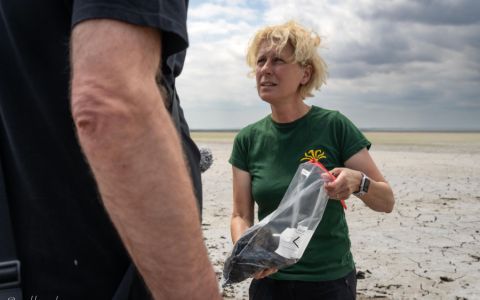Recent laboratory tests conducted by Arnika, dTest, and consumer associations from Hungary, Austria, and Slovenia revealed shocking results. The tests found that one in three underwear products contains toxic chemicals, and one in ten contains harmful levels of these substances.
Bisphenols are commonly found in polycarbonate plastics and epoxy resins, but they are also used as additives, such as color stabilizers in textiles.
Even at very low levels, bisphenols act as endocrine disruptors, interfering with the normal functioning of the hormone system. People are exposed to bisphenols daily through a variety of products they use, as well as from the contamination of food and water. Bisphenols can negatively affect fetal and child development and are linked to an increased risk of cardiovascular diseases, neurological disorders, reproductive abnormalities, obesity, and diabetes. Prenatal exposure to bisphenols can result in developmental disorders, and there is an increased risk of hormone-related cancers associated with bisphenol exposure.
Human biomonitoring studies have shown widespread exposure to Bisphenol A (BPA), the most extensively studied chemical in the bisphenol group, with data indicating that 92% of adults from 11 European countries had BPA in their urine.
New Types of Bisphenols: Hidden Toxins
The leaching of bisphenols from plastic goods, kitchen utensils, and drinking bottles, as well as potential absorption through the skin, has already led to the ban of one specific bisphenol, bisphenol-A (BPA), in products like thermal paper (used in receipts) and baby bottles. Bisphenols classified as reproductive toxins are also banned in toys.
“The regulatory action clearly lags behind the scientific evidence. Bisphenols are still present in many consumer products, including children's apparel. It’s ironic that doll clothing has stricter limits on bisphenols than clothing for small children,” says Karolina Brabcova, consumer campaigns manager at Arnika’s Toxics and Waste Programme.
Worldwide, 80% of synthetic fibers undergo some form of color-fastening treatment. In materials like spandex and elastane, certain chemical auxiliaries are used as color fasteners. These substances contain bisphenol-S and bisphenol-F, and residues of these chemicals are inevitably present in the final product.
“Unfortunately, manufacturers are replacing BPA with other types of bisphenols, which can pose similar health risks. These include bisphenol-S and bisphenol-F, which are not banned yet,” adds Karolina Brabcova.
The test was conducted by Arnika in an accredited international laboratory. A total of 166 different types of underwear were tested as part of a unique international collaboration between consumer associations from Czechia, Austria, Hungary, and Slovenia.
Shocking results affecting our health
The test revealed alarming levels of toxic contamination:
- One-third (30%) of the tested underwear contained some form of bisphenol (BPA, BPS, or BPF).
- Additionally, 10% of all samples showed bisphenol levels well above the maximum amount considered safe for human health, with an average of 11 mg/kg of bisphenols.
- The highest concentration found in a single sample was 301 mg/kg, which accounts for 0.03% of the product's weight!
In 2023, the EU Food Safety Authority reduced the daily intake limit for bisphenols to 0.2 nanograms per kg of body weight—a drastic reduction to just 1/20,000th of the previous recommendation, due to the highly toxic nature of bisphenols. Based on the recent results of the aforementioned test, Arnika is proposing to ban bisphenols in all types of consumer products that are not yet regulated.
Women are at higher risk
17% of products for women contained high levels of bisphenols, because women´s lingerie is predominantly made of synthetic materials.
“Although cotton products are available for women, our initial market research showed that majority of women’s panties are made from synthetic materials. This immediately implies a greater risk of exposure to bisphenols,” says Júlia Dénes, chemist at the Hungarian Association of Conscious Consumers who participated in the study too.
Avoid synthetic fibres, choose cotton!
Test results show that underwear made from synthetic fibers increases the risk of exposure to bisphenols. Surprisingly, the test found bisphenols in products from well-known brands, while underwear purchased from cheaper stores was mostly bisphenol-free.
Overall, the results suggest that underwear with a high cotton content is unlikely to contain bisphenols, regardless of the brand name or place of production.
Washing underwear is not a solution!
The study also examined whether bisphenols could be washed out of the underwear. Arnika and its partners selected 16 samples with the highest bisphenol concentrations for washing and re-testing. Most of the samples were women’s products. When analyzing the average total bisphenol content, the results showed an overall reduction of bisphenols by 74%.
However, the individual results were more complex. While some samples showed a reduction of 90-99% in bisphenol levels, others remained unchanged and 4 samples exhibited higher bisphenol levels after washing. According to the laboratory, this phenomenon can be explained by the migration of bisphenols from one part of the underwear to another during washing.
Overall, the data indicates that washing the underwear reduces the risk of bisphenol exposure for the wearer. However, this also suggests that bisphenols may be polluting the environment if not fully removed by wastewater treatment. In addition, all samples were still classified as high-risk even after washing. Although the reduction of bisphenols in the underwear was significant, the initial concentrations were so high that, after washing, all 16 products still contained more than 0.8 mg/kg of bisphenols.
NGOs call for a ban of toxic chemicals in consumer products – the ToxFreeLifeForAll project
The introduction of a new chemical to the EU market can take up to six months. In contrast, if these substances are classified as toxic, it can take up to 20 years to ban them from consumer products.
This imbalance between the speed of industrial innovation and consumer protection is unsustainable and needs urgent attention. That is why Arnika and the project partners are urging European policymakers to implement a swift ban on toxic chemicals in consumer products.
Support these efforts and public health policies by signing a call to action for European politicians. We must ban all substances of concern from consumer products by 2029!
For further information, please contact:
Karolina Brabcova, Consumer campaigns manager at Arnika, Czechia: This email address is being protected from spambots. You need JavaScript enabled to view it. / +420 731 321 737
ToxFreeLIFEforAll project is funded by the European Union’s LIFE programme. It aims to protect health and the environment from the risks posed by harmful chemicals in everyday consumer goods. The partner organizations involved are Arnika and dTest from the Czech Republic, ZPS from Slovenia, VKI from Austria, Association of Conscious Consumers from Hungary.
Funded by the EU Life Programme (LIFE22-GIE-HU-ToxFree LIFE for All, 101114078). Views and opinions expressed are however those of the author(s) only and do not necessarily reflect those of the European Union. Neither the European Union nor the granting authority can be held responsible for them.








